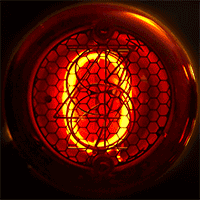
A Nixie tube (English: NIK-see), or cold cathode display, is an electronic device used for displaying numerals or other information using glow discharge.
The glass tube contains a wire-mesh anode and multiple cathodes, shaped like numerals or other symbols. Applying power to one cathode surrounds it with an orange glow discharge. The tube is filled with a gas at low pressure, usually mostly neon and a small amount of argon, in a Penning mixture. In later nixies, in order to extend the usable life of the device, a tiny amount of mercury was added to reduce cathode poisoning and sputtering.
Although it resembles a vacuum tube in appearance, its operation does not depend on thermionic emission of electrons from a heated cathode. It is hence a cold-cathode tube (a form of gas-filled tube), and is a variant of the neon lamp. Such tubes rarely exceed 40 °C (104 °F) even under the most severe of operating conditions in a room at ambient temperature. Vacuum fluorescent displays from the same era use completely different technology—they have a heated cathode together with a control grid and shaped phosphor anodes; Nixies have no heater or control grid, typically a single anode (in the form of a wire mesh, not to be confused with a control grid), and shaped bare metal cathodes.